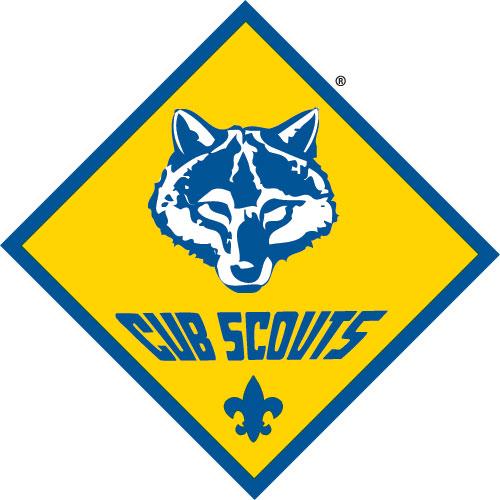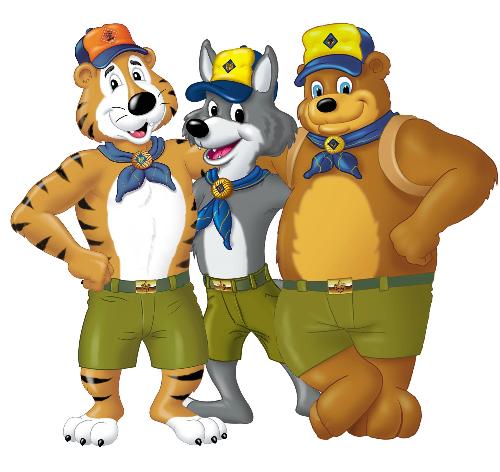What is Cub Scouting?
The Purposes of Cub Scouting
Since 1930, the Boy Scouts of America has helped younger boys through Cub Scouting. It is a family program designed for boys who are in the first grade through fifth grade (or 7, 8, 9, and 10 years of age). Parents, leaders, and organizations work together to achieve the purposes of Cub Scouting. Currently, Cub Scouting is the largest of the BSA's three membership divisions. (The others are Boy Scouting and Venturing.)
 |
The ten purposes of Cub Scouting are:
Character Development
Spiritual Growth
Good Citizenship
Sportsmanship and Fitness
Family Understanding
Respectful Relationships
Personal Achievement
Friendly Service
Fun and Adventure
Preparation for Boy Scouts
|

|
Membership
Every Cub Scout pack, Boy Scout troop, and Venturing crew belongs to an organization with interests similar to those of the BSA. This organization, which might be a church, school, community organization, or group of interested citizens, receives a charter from the BSA to use the Scouting program.
Cub Scouting members join a Cub Scout pack and are assigned to a den, usually a group of eight to ten boys. Tiger Cubs (first-graders), Wolf Cub Scouts (second-graders), Bear Cub Scouts (third-graders), and Webelos Scouts (fourth- and fifth-graders) meet regularly, usually monthly for the younger scouts and more frequently for the Webelos. Once a month, all of the dens and family members gather for a pack meeting under the direction of a Cubmaster and pack committee. The committee includes parents of boys in the pack and members of the chartered organization.
Groups responsible for supporting Cub Scouting are the boys and their parents, the pack, the chartered organization, and the community. The boy is encouraged to pay his own way by contributing dues annually. Packs also obtain income by working on approved fundraisers.
Volunteer Leadership
Each chartered organization appoints one of its members as a chartered organization representative. This organization, through the pack committee, is responsible for providing leadership, the meeting place, and support materials for pack activities. Thousands of volunteer leaders, both men and women, are involved in the Cub Scout program. They serve in a variety of positions, everything from unit leaders to pack committee chairmen, committee members, den leaders, and chartered organization representatives.
Publications
Volunteers are informed of national news and events through Scouting magazine. Boys may subscribe to Boys' Life magazine. Both are published by the Boy Scouts of America. Also available are a number of youth and leader publications, including the Tiger Cub Handbook, Wolf Handbook, Bear Handbook, Webelos Handbook, Cub Scout Leader Book, Cub Scout Program Helps, and Webelos Leader Guide.
Cub Scouting Ideals
Apart from the fun and excitement of Cub Scout activities, the Cub Scout Promise, the Law of the Pack, and the Cub Scout sign, handshake, motto, and salute all teach good citizenship and contribute to a boy's sense of belonging.
Cub Scout Oath
On my honor I will do my best
To do my duty, to God and my country
And to obey the Scout Law;
To help other people at all times;
To keep myself physically strong,
mentally awake, and morally straight.
Cub Scout Motto
Do Your Best.
The Scout Law
A Scout Is Trustworthy, Loyal, Helpful, Friendly, Courteous, Kind, Obedient, Cheerful, Thrifty, Brave, Clean, And Reverent.
Colors
The Cub Scout colors are blue and gold. They have special meaning, which will help boys see beyond the fun of Cub Scouting to its ultimate goals. The blue stands for truth and spirituality, steadfast loyalty, and the sky above. The gold stands for warm sunlight, good cheer, and happiness.
Advancement
Recognition is important to young boys. The Cub Scouting advancement plan provides fun for the boys, gives them a sense of personal achievement as they earn badges, and strengthens family understanding as adult family members work with boys on advancement projects.
Bobcat
No matter what age or grade a boy joins Cub Scouting, he must earn his Bobcat badge before he can advance to the rank of Tiger, Wolf, Bear, or Webelos. A boy must complete the Bobcat requirements, which include:
· Learn and say the Cub Scout motto, the Scout Oath, and the Scout Law and tell what they mean;
· Show the Cub Scout sign, salute, and handshake and tell what they mean; and
· With your parent or guardian complete the exercises in the pamphlet How to Protect Your Children from Child Abuse: A Parent's Guide.
Tiger Cub
The Tiger rank is for boys who are in first grade or are age 7. To earn the Tiger badge, a boy must complete six required adventures with his den or family and one elective adventure of his den or family’s choosing. As the boy completes each adventure, he will receive the adventure loop for that adventure, which he can wear on his belt. When the boy has completed the seven required adventures, he can receive the Tiger badge. The Tiger badge is given to the boy’s adult partner at a pack meeting. Then, during a grand ceremony, the adult gives the badge to the boy.
After he has earned the Tiger badge, a Tiger Scout can work on the remaining 12 Tiger electives until he finishes first grade (or turn 8 years old). He can choose elective adventures that may show him new hobbies and teach him skills that will be useful during his Boy Scout years. When he completes an elective adventure, he receives an additional adventure loop to wear on his belt.
Wolf
The Wolf rank is for boys who have finished first grade (or who are 8 years old). To earn the Wolf badge, a boy must complete six required adventures and one elective adventure. His parent or guardian and den leader approves each requirement by signing his book, and the boy receives an adventure loop for each adventure. When the boy has met all requirements, the Wolf badge is presented to his parent or guardian at the next pack meeting. During an impressive ceremony, the parent or guardian then presents the badge to the boy.
After he has earned the Wolf badge, a Wolf Scout can work on the remaining 12 Wolf electives until he finishes second grade (or turns 9 years old). He can choose elective adventures that may show him new hobbies and teach him skills that will be useful during his Boy Scout years. When he completes an elective adventure, he receives an additional adventure loop to wear on his belt.
Bear
The Bear rank is for boys who have finished second grade (or who are 9 years old). To earn the Bear badge, a boy must complete six required adventures and one elective adventure. His parent or guardian and den leader approves each requirement by signing his book, and the boy receives an adventure loop for each adventure. When the boy has met all requirements, the Bear badge is presented to his parent or guardian at the next pack meeting. During an impressive ceremony, the parent or guardian then presents the badge to the boy.
After he has earned the Bear badge, a Bear Scout can work on the remaining 12 Bear electives until he finishes third grade (or turn 10 years old). He can choose elective adventures that may show him new hobbies and teach him skills that will be useful during his Boy Scout years. When he completes an elective adventure, he receives an additional adventure loop to wear on his belt.
Webelos
Webelos dens are for boys who have completed third grade (or reached age 10). Webelos Scouts get to work on the five required Webelos adventures and choose two of the 18 elective adventures that are shared by the Webelos and Arrow of Light ranks.
When a boy has done the requirements for an adventure, the Webelos den leader, rather than a parent, approves most of the adventures. For each adventure a boy completes, he receives a pin to wear on the Webelos colors or on his hat. After completing seven adventures, including five required adventures and two elective adventures, a Scout can receive the Webelos badge.
After he has earned the Webelos badge, a Webelos Scout can work on the remaining 18 shared Webelos and Arrow of Light electives until he finishes fourth grade (or turns 11 years old). He can choose elective adventures that may show him new hobbies and teach him skills that will be useful during his Boy Scout years. When he completes an elective adventure, he receives an additional adventure pin to wear on the Webelos colors or on his hat.
Arrow of Light
The highest rank in Cub Scouting is the Arrow of Light. Earning this rank prepares a Webelos Scout to become a Boy Scout. Scouts must complete four required adventures and three elective adventures to earn the Arrow of Light rank. For each adventure a boy completes, he receives a pin to wear on the Webelos colors or on his hat.
The Arrow of Light badge is the only Cub Scout badge that can be worn on the Boy Scout uniform when a boy graduates into a troop.
Activities
Cub Scouting means "doing." Everything in Cub Scouting is designed to have the boys doing things. Activities are used to achieve the aims of Scouting—citizenship training, character development, and personal fitness. Many of the activities happen through the den and pack meetings.
Camping
Age-appropriate camping programs are packed with theme-oriented action that brings Tiger Cubs, Cub Scouts, and Webelos Scouts into the great outdoors. Day camping comes to the boy in neighborhoods across the country; resident camping is at least a three-day experience in which Cub Scouts and Webelos Scouts camp within a developed theme of adventure and excitement. Cub Scout pack families enjoy camping in local council camps and other council-approved campsites. Camping programs combine fun and excitement with doing one's best, getting along with others, and developing an appreciation for the world of the outdoors.